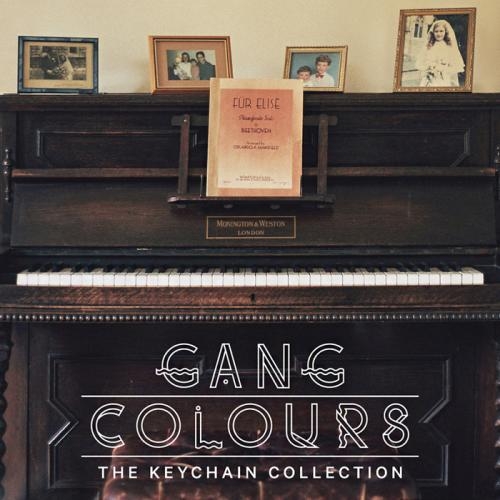The piano on the cover to Gang Colours’ debut album The Keychain Collection is a little misleading – but not entirely. Seeing an old upright relic like the one shown on the album cover – complete with Beethoven music book – could well lead one to think the music held within will be of the classical nature, or extremely homely, like the sound of the first Perfume Genius album. Look at those pictures on top, too; it’s almost like it’s setting the scene for you. But then your eyes catch the font: while the album’s title is in respectable block capitals, the artist’s name is a curious invented kind, almost symbolic, like it was influenced by cave drawings. With this registered, the image behind the letters seems odd now, like the two have been mismatched. In terms of a comparison for the actual music on the album, it’s not a bad start.
Let me go back to my original point: there’s piano on the album – in fact it’s the main instrument present here – but it always feels like it’s scattered across these ten tracks, amidst all the stuttering beats, low bass, clicking effects, and mournful vocals. It’s an album that feels both loosely knitted and tightly stitched together. There’s a very admirable intricacy to each track, which is one of the album’s most appealing features; it’s always interesting to listen to when you dip more than your toe in its waters. But nothing feels set in stone; the music flows seamlessly and freely, like a trickling stream. Nothing feels like it’s going in a specific direction, but nothing feels aimless. “Fancy Restaurant” is probably the best example here – and probably the best track, too. The song has numerous core elements – the two line repeated vocal phrase, the warmly buzzing synth line, the descending piano line – but they go in and out of the picture while an imaginative stop and start click track keeps them all linked together. It’s the kind of detailed track that works so well, and sounds so seamless, that makes it better to be heard than to be described. In fact, you could say that about anything here. The tracks are detailed and dynamic; words only go so far, or can describe a few traits on offer, or give a general feel.
Strangely, though, it never keeps your attention for as long as it should. These tracks are wonderful to hear, but much like any distinguishable feature that appears on any song, it’ll go in and out of focus. “To Repel Ghosts” has plenty going on, but unless you’re invested in it completely, you’re only likely to be hooked in when Will Ozanne’s defeated vocal refrain comes in, singing “Will I ever find out,” like he’s been holding every hope on knowing something we have no idea about. Much the same can be said for the following rainy-day track, “I Don’t Want You Calling,” or the cooing on “Tissues and Fivers,” where your attention is drawn in when the human element comes into the picture (even if it is a somewhat skewed, as in the case of the latter track).
Comparisons to James Blake aren’t entirely off, but there’s definitely a more widespread influence from the world of dubstep and hip-hop present here. It’s taken Ozanne ten years to release music with a sound he’s happy with, and The Keychain Collection definitely sounds like it has soaked up a lot of outsider influence over that time. Contrastingly, though, the album seems concerned with a very particular time-frame. Going by track titles (which isn’t ideal, but when the lyrics are as few and far between as they are here, what else can you do?), it would seem that “Heavy Petting” is where a relationship problem begins, leading onto “Forgive Me?” and “I Don’t Want You Calling”. Whether or not things are fixed by the album’s end isn’t entirely clear, but “Fancy Restaurant” would certainly indicate Ozanne has a new apple of his eye. Analysis of this sort seems rather pointless and inane, though. Ozanne may have particular people and situations in mind for each track, but it seems intentional that specifics aren’t really mentioned. It feels much more like a mood album than anything else, as he tries to capture simple beauty, but also reoccurring sadness.
It is sad, but never so much so that it can depress the listener; it does capture some lovely musical moments, but it falls just short of being beautiful. The fact is when I think about the album I keep returning to the same point: this is interesting music to listen to, or even to have on in the background. There’s nothing bad about it – at all – but considering how much work seems to have gone into it, it should feel that bit more captivating.

